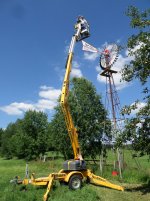On my JLG, there is a tap into the hydraulic lift line which feeds the work platform pitch angle. The pitch cylinder is sized such that a horizontal work platform position is maintained no matter what the elevation. Mine also has a yaw angle rotator so that I can square up the platform angle with the wall of a building or sneak around a limb as necessary.
As long as you are comfortable with your lift, one or both of these features could be added. I'd also suggest adding some baseboards aound the base of the platform. Sometimes you have tools and cans of gas/oil/paint, etc. that you don't want to roll overboard.
As long as you are comfortable with your lift, one or both of these features could be added. I'd also suggest adding some baseboards aound the base of the platform. Sometimes you have tools and cans of gas/oil/paint, etc. that you don't want to roll overboard.
